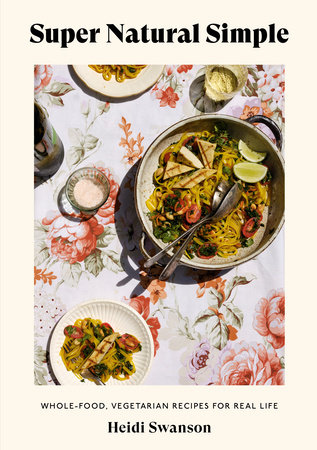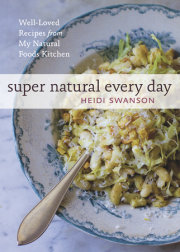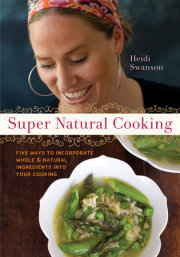IntroductionThe cookbooks I love always have a strong sense of place, so if you’ll indulge me a bit, I’ll paint a picture of where this one originates. I’m writing from a small, sunny kitchen in a century-old Spanish bungalow. A bird’s-eye view places me a block from an expansive stretch of beach running a few miles in length—from a neat-as-a-pin marina to a craggy jetty at the end of a long, dancer’s leg of a peninsula. You can’t go much farther south and still be in Los Angeles County. It’s California, at volume ten.
At this moment, a glance through our south-facing windows reveals electric-red pomegranate flower blossoms and fiery banks of bougainvillea. From what I can tell, the plants here are happy, and I’m trying to get passion fruit, Arabian jasmine, kishu mandarins, makrut lime, and tiny rosella seedlings to take hold in a postage stamp–size space. There are herbs like tulsi and African basil, marjoram, yerba buena, and tangerine sage sprinkled about, and I water them with an old-fashioned metal watering can because I have yet to figure out the drip line.
I throw most of our meals together with ingredients I keep on hand. My goal is always to fix vibrant, nutrient-packed meals made primarily from whole, natural foods and I try to set up my kitchen to encourage and support that. When I open my pantry door, I see brown jasmine rice, dried mushrooms, chickpea pastas, tri-colored quinoa, fire-roasted tomatoes, and a rainbow of beans and lentils. Beyond that, seasonal vegetables set the tone for most meals, and I keep as many within eyesight as possible. This way, I’m more likely to integrate them into whatever I’m cooking.
California has enviable year-round farmers’ markets, and Los Angeles has a great climate for maintaining a garden. For both, I’m exceptionally thankful. Intense, fresh, and bright flavors are what I crave and what inspire everything I cook. But if I’m being honest, my days are fuller than ever, and this detail, this busyness, is what defines my everyday cooking style as much as anything else. The more hectic my life becomes, the simpler my cooking has to be.
Simple is more of a feeling than anything else, and it’s something I increasingly chase. A recipe that roasts for thirty minutes but only takes ten to get in the oven? Simple. Leveraging freezer items? Simple. A cake that comes together in one bowl? Yes, please. Generally speaking, balancing the idea of simple cooking while keeping things interesting is my sweet spot. I try to maintain efficiency in the kitchen without sacrificing flavor. When I’m cooking now, I’m most excited by recipes that are both succinct and special.
What you’ll find here is a collection of whole-food, vegetarian recipes, all of which have been pared down for quick weeknight cooking via short ingredients lists, make-ahead techniques, and smart methods to create high-impact meals full of flavor, color, and nutrition. These are laid-back, crowd-pleasing power recipes rooted in plants, spices, color, nutrients, and flavor—the kinds of dishes that are manageable on a weeknight.
STAY CONNECTED TO WHAT YOU EAT
In 2007, I wrote
Super Natural Cooking. It was a cookbook celebrating the power of natural foods at a time when cooking with whole grains and focusing on nutrient-dense plant-based ingredients wasn’t as popular.
Super Natural Cooking and its 2011 follow-up,
Super Natural Every Day, highlighted a style of cooking and sourcing of ingredients that felt right to me. It made sense to eat real food and cook using mindfully grown, thoughtfully sourced ingredients. The case for vegetarianism (and veganism) was similar then to what it is now: better for the planet, better for the animals, better for our health and well-being.
In the years since, I’ve watched the coming and going of so many diet, eating, and cooking trends: Whole30, Atkins, low-carb, Paleo, Keto, turmeric-everything, warm lemon juice every morning, cupboards dedicated to smoothie powders, extensive supplement and vitamin programs, and on and on. It’s an intense and often overwhelming ecosystem, created by networked information culture, food politics, and diet wars colliding with people who are genuinely hoping to find their way to balance and good health. Unfortunately, many people end up ping-ponging from one trend and headline to the next.
When you cut through all of the claims and look at communities with the strongest longevity pockets, communities with elderly populations that experience a good quality of life well into their eighties and nineties, you find common threads. These folks tend to eat a 90 to 100 percent plant-based diet. And they build meals around greens, whole grains, beans, nuts, and tubers. So, while a lot of the information out there can be fun, inspiring, compelling, and, in many cases, helpful, finding your way to nutrient-rich, whole-food, plant-based meals is probably where you want to settle.
The trick, of course, is to identify and consistently integrate this type of cooking (and eating) into your life. My hope is that
Super Natural Simple can step in here. If you are looking for approachable ways to work more vegetables and whole foods onto your plate, this book is for you. If you’re looking for ways to phase out processed ingredients, restaurant meals, and take-out in place of super natural, weeknight-friendly meals, this book will help.
Natural foods and whole ingredients are wonderful, powerful, and often very beautiful. The magic (and benefits!) of integrating them into the rhythm of your life is real. Staying connected to what you eat is one of the most impactful ways to support your health and well-being. And modern life makes it so easy to disconnect with its bounty of prepared foods, restaurants, and delis.
The point of this book is to make you want to walk into your kitchen and cook healthful, wholesome meals. Even within the demands of modern life, regularly cooking for yourself can be transformational, and these recipes are definitely doable. Cooking and eating with others is one of the daily rituals that ties us together as human beings. If cooking hasn’t previously been your thing, it’s okay! It can be an adventure of sorts and an exciting world of deliciousness to explore. Experiment with new recipes a couple of times a week and, before you know it, you will have built a repertoire of go-to dishes you’re excited about.
Copyright © 2021 by Heidi Swanson. All rights reserved. No part of this excerpt may be reproduced or reprinted without permission in writing from the publisher.








